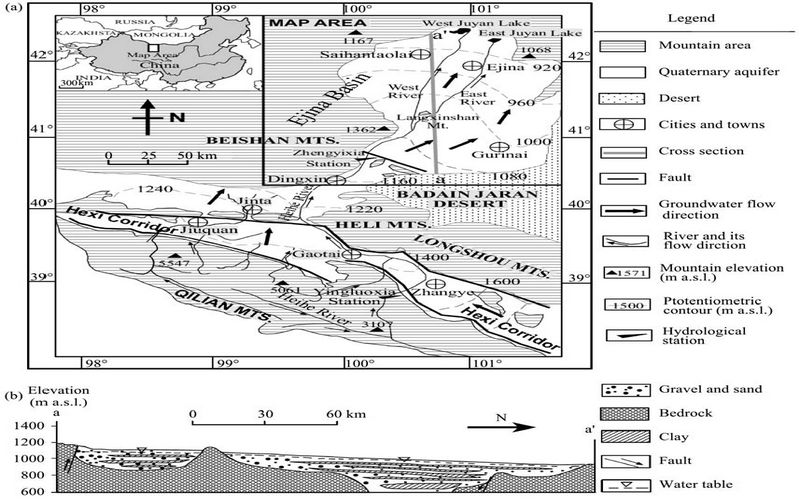Characterization of groundwater in the Ejina Basin, northwest China: hydrochemical and environmental isotopes approaches
Updatetime:2010-12-29From:
【Enlarge】【Reduce】
To characterize the groundwater in the Ejina Basin, surface and groundwater samples were collected in May and October of 2002. On-site analyses included temperature, electrical conductance (EC), total alkalinity (as HCO3−) by titration, and pH. Chemical analyses were undertaken at the Geochemistry Laboratory of the Cold and Arid Region Environmental and Engineering Institute, Chinese Academy of Sciences, Lanzhou, China. The pH of the groundwater ranged from 7.18 to 8.90 with an average value of 7.72, indicating an alkaline nature. The total dissolved solids (TDS) of the groundwater ranged from 567.5 to 5,954.4 mg/L with an average of 1,543.1 mg/L and a standard deviation of 1,471.8 mg/L. According to the groundwater salinity classification of Robinove et al. (1958), 47.4 percent of the samples were brackish and the remainder were fresh water. The ion concentration of the groundwater along the riverbed and near the southern margin of the basin were lower than those farther away from the river-bed. The groundwater in the study area was of Na+-HCO3− type near the bank of the Heihe River and in the southern margin of the basin, while Na+-SO42−-Cl− type samples were observed in the terminal lake region. In the desert area the groundwater reached a TDS of 3,000–6,000 mg/L and was predominantly by a Na+-Cl− chemistry. Br/Cl for the water of Ejina Basin indicates an evaporite origin for the groundwater with a strongly depleted Br/Cl ratio (average 0.000484). The surface water was slightly en-riched in Br/Cl (average 0.000711) compared with groundwater. The calculated saturation index (SI) for calcite and dolomite of the groundwater samples range from −0.89 to 1.31 and −1.67 to 2.67 with averaged 0.24 and 0.61, respectively. About 97 percent of the groundwater samples were kinetically oversaturated with respect to calcite and dolomite, and all the samples were below the equilibrium state with gypsum. Using isotope and hydrochemical analyses, this study investigated the groundwater evolution and its residence time. The groundwater content was mainly determined by the dissolutions of halite, gypsum, and Glauber’s salt (Na2SO4), as well as Na+ exchange for Ca2+, and calcite and dolomite precipitation. With the exception of a few locations, most of the groundwater samples were suitable for irrigation uses. Most of the stable isotope compositions in the groundwater sampled plotted close to the Global Meteoric Water Line (GMWL), indicating that the groundwater was mainly sourced from meteoric water. There was evidence of enrichment of heavy isotopes in the groundwater due to evaporation. Based on the tritium content in atmospheric precipitation and by adopting the exponential-piston model (EPM), the mean residence time of the unconfined aqui-fer groundwater was evaluated. The results show that these groundwaters have low residence time (12 to 48 years) and are re-newable. In contrast, the confined groundwater had 14C ages estimated by the Pearson model between 4,087 to 9,364 years BP. Isotopic signatures indicated formation of deep confined groundwaters in a colder and wetter climate during the late Pleistocene and Holocene.
|
(a) The setting of the Heihe River Basin showing the hydrological systems in relation to the main flow direction of groundwater and surface water toward the terminal lakes. The geological cross sections of Figure 1b (a–a') are indicated. (b) Hydrogeologic cross sections along transect a–a' in Figure 1a. (Picture/Sciences in Cold and Arid Regions) |
Appendix





